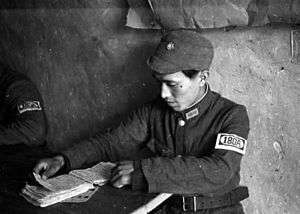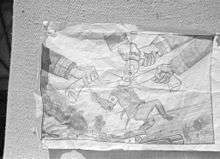Japanese People's Emancipation League
Not to be confused with Japanese People's Anti-war Alliance.

A former Japanese POW now a Emancipation League member in an Eighth Route Army uniform. (Photo taken by Harrison Forman)

Illustration of Allied countries strangling Hideki Tojo. Flags representing Great Britain, Republic of China, the Japanese People's Emancipation League, and the United States are pictured on the sleeves of each hand.
The Japanese People's Emancipation League (Japanese: Nihon Jinmin Kaiho Renmei)[1] or Emancipation League, was a Japanese resistance organization that operated in communist China during the Second Sino-Japanese War, and World War II.[2]
History
In 1944, the Japanese People's Emancipation League was established in Yan'an.[2] The Emancipation League had a three-point program: "opposition to the war, the overthrow of the militarists, and the establishment of a democratic, people's government in postwar Japan".[2] It was estimated that the Japanese People's Emancipation League had numbered more than 300[3] to 450 members.[1]
Banner
The Japanese People's Emancipation League had a banner.[4]
List of Members
See also
- Japanese in the Chinese resistance to the Empire of Japan
- Japanese dissidence during the Shōwa period
- League to Raise the Political Consciousness of Japanese Troops
- National Committee for a Free Germany
Further reading
- United States. Congress. Senate. Committee on the Judiciary (1951). Institute of Pacific Relations. pt 7. Washington, U.S. Govt. Print. Off. pp. 2450–2474.
- United States. Congress. Senate. Committee on the Judiciary (1956). Scope of Soviet activity in the United States. Parts 50-54. United States. Congress. Senate. Committee on the Judiciary. pp. 3502–3505.
- Japanese American Committee for Democracy. Japanese People's Emancipation League: It's Program and Ativities: A Japanese People's Movement for a Democratic Japan. 1945.
- Xiaoyuan Liu (1956). A Partnership for Disorder: China, the United States, and Their Policies for the Postwar Disposition of the Japanese Empire, 1941-1945. Cambridge University Press. p. Jul 25, 2002.
- Israel Epstein. My China Eye: Memoirs of a Jew and a Journalist.
- Ariyoshi, Koji (2000). From Kona to Yenan: The Political Memoirs of Koji Ariyoshi. University of Hawaii Press.
- Agnes Smedley (1972). Great Road. NYU Press. p. 388.
External links
- "Jap Communists Will Be Powerful Influence". Tribune. Oct 26, 1945.
- "Communism a Misnomer in China, Says Forman". The Milwaukee Journal. Mar 11, 1945.
- "Visit To Eight Route Army". The Sydney Morning Herald. Jul 12, 1944.
- "Trouble Grows in Japan". Army News. 8 August 1944.
- "Jap Anti-War Leager Sees Hope". Tribune. Jun 14, 1945.
- "Oral History Interview with John S. Service". Harry S. Truman Library and Museum.
References
- 1 2 United States. Congress. Senate. Committee on the Judiciary (1956). Scope of Soviet activity in the United States. Parts 50-54. United States. Congress. Senate. Committee on the Judiciary. pp. 3502–3505.
- 1 2 3 Roth, Andrew (1945). Dilemma in Japan. Little, Brown. pp. 162-188
- ↑ Life December 18, 1944
- ↑ "Yanan (China), banners for school and Japanese People's Emancipation League". University of Wisconsin–Milwaukee. 1944.
This article is issued from Wikipedia - version of the 11/24/2016. The text is available under the Creative Commons Attribution/Share Alike but additional terms may apply for the media files.
